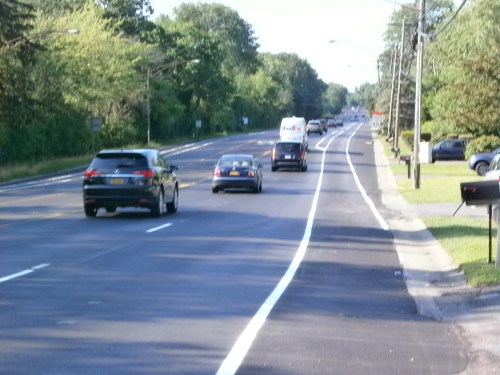The College of St. Rose “Chronicle” nicely picked up on the Madison Avenue Traffic Calming letter ABC sent to Albany Police Department’s Traffic Engineering. ABC voiced support for the “traffic calming” proposals put forth but asked that the bicycle lanes be six (not five) feet wide. This sentiment was echoed in the article by recently re-elected (in the face of anti-bicycle lanes backlash) 10th Ward Common Council Member Leah Golby.
History buffs – and bicycle and pedestrian advocates looking for support for their own cause – will enjoy the comments by City Historian Tony Opalka about the “transposition powerhouse of the day” (the canal lobby) banning railroads from crossing the Great Western Turnpike (Western and Madison Aves.). If you ratchet up the dates to the present and the contenders (motor vehicle/big petro/big construction lobbies vs. cyclists and pedestrians) you’ll see that we are in the same fix today – those who have a right to locomotion are constrained by road and street design from exercising that right in safety.
The Text of the ABC letter follows:
Since April 16, 2013 when Creighton-Manning presented its suggested Madison Ave. “road diet” treatments for Madison Ave., the Albany Bicycle Coalition has considered many different approaches, and has concluded that there is only one that maximizes bicyclist safety, and would, therefore, encourage new cyclists. That approach is a modified “Option C” (in-road bicycle lanes), with the bicycle lanes widened to six feet to provide a sufficient safety margin.
By way of explanation, ABC’s goals remain firmly as follows:
• Calm Traffic on Madison Ave. – For the benefit of cyclists, pedestrians, transit users, and motorists.
• Make Madison Ave. the City’s Main East-West Bicycle Corridor – Of our three radial streets, only the Madison-Western Ave. combination offers all the desired benefits without negative impact on other street users. It has all the major destinations and connects easily with all major cross streets. With its expected continuation east to the river and west to Guilderland, it will be the heart of the long-needed “river-to-Fuller” bicycle route.
The consulting engineer’s Madison Ave. traffic calming study suggested only three options to meet the goals of that road diet. The suggested options (with ABC annotations) are as follows:
A. Shared Lanes in Travel Lanes – This option is unsuited to most cyclists. While shared lane have been installed elsewhere in the city to great benefit, their use on Madison Ave. would undercut the goal of its being a major route suited to cyclists of all skill levels.
B. Shared Lanes in Parking Lanes – This option seems to be used rarely elsewhere and exacerbates the potential for collisions between cyclists and opening doors of parked vehicles. ABC members who have ridden these “parking-bicycle lanes” found them unsuitable. This option should be considered only as a last resort.
C. Five-Foot Bicycle Lanes – This is the preferred of the three options. However, we believe that five-foot lanes would deter many would-be cyclists. The margin of safety with five-foot bicycle lanes is just not sufficient.
Thus, these three options have extremely limited potential for bringing new cyclists onto the streets. Options A and B might be suitable for experienced cyclists, but those cyclists are already accustomed to riding on streets with no bicycling features at all.
The overarching goal for the City of Albany is to build cycling infrastructure that will attract current non-riders, as well as those who hesitate to ride on the street with motorized traffic. Only by working toward this goal can we realize lower pollution, more parking, less traffic congestion, more public safety, improved health, and increased pedestrian use of the streets.
Consistent with that goal, our position is that a modified Option C – with wider bike lanes – is the best way to bring about the city’s objectives:
• The consulting engineer’s Option C consists of five-foot bicycle lanes located at the right side of the travel lane, adjacent to the parking lane.
• However, based on our extensive experience, five feet is not sufficient to protect cyclists from car doors, and from wide commercial vehicles parked at the curb.
• Therefore, we propose that the bicycle lanes be a minimum of six feet wide. Our design obtains the extra two feet (total) by subtracting approximately eight inches from each of the three motor vehicle drive lanes.
These modifications are feasible and justifiable. They vastly improve the safety of Option C, and they preserve the intent of the consulting engineer’s proposal. If implemented, they will provide a safe, inviting, Madison-Western east-west bicycle corridor that the city needs in order to become a real bicycling community.
We look forward to working with you and other project staff and supporters to realize the development of the Madison Ave. bicycle route.
 But there’s more…
But there’s more…













